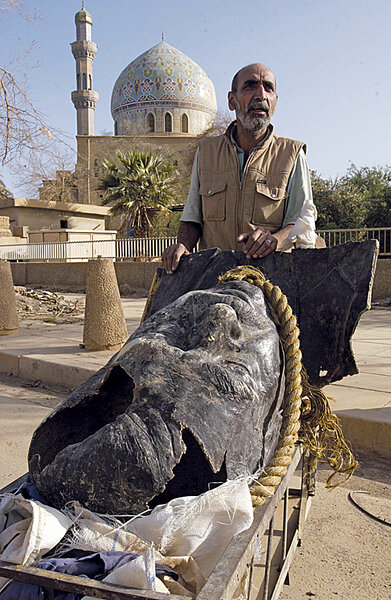Iraq war: On the road to Baghdad for 17 days
| Manhattan, Kan.
When I crossed into Iraq from Kuwait on March 22, 2003, I was reminded of the scene at the end of the movie "Field of Dreams." A glowing line of car headlights snakes into the distance as the sun sets over Iowa, the cars heading to the baseball field.
But in Iraq, the rising sun cast an orange glow over the dusty desert landscape. The headlights of scores of military vehicles aligned neatly as the troops rushed north to war.
I was on the road to Baghdad for 17 days.
I came across discarded army boots along the highway. Military-aged men in street clothes walked in small groups as US convoys rolled past. A dust storm kicked up, and I was awed by nature's ability to bring the most lethal military force on earth to a dead stop.
We rolled through towns and villages in the Shiite south, where marines were greeted with curiosity and skepticism. There was no love for Saddam Hussein but groups of men and boys peppered the marines with questions. Would the Americans abandon them again like they did in 1991? How long will the war last?
I had questioned President George W. Bush's decision to invade. But seeing the faces of these Iraqis made me wonder if it wasn't a good call after all. As we now know, the Iraq war that Americans had been promised would be over within months, largely paid for by Iraqi oil, lasted for eight years and cost $800 billion.
By April 8, I was on the outskirts of Baghdad. Looting was rampant in the countryside, and US forces were doing little to stop it. Combines, horses, cars, food, and furniture were all being hauled away. Factories were ransacked, and I wondered if this would one day be looked on with regret. Wouldn't the factories be needed so people could work? Wasn't there a plan for security?
On the morning of April 9, the marines showed me an Iraqi military outpost they said appeared to be a terrorist bombmaking factory. Booby-trapped dolls, alarm clocks wired for use as detonators, and explosives littered the place. The marines were worried about what it meant. (As it happened, the US invasion didn't have the manpower to secure Mr. Hussein's abandoned arms depots, and weapons from his arsenal were ultimately looted for use by insurgents, ending up in the improvised explosive devices that cost so many lives and limbs.)
By midafternoon that day, we were closer to Baghdad. I was scheduled to talk with an American TV network about the marines' find. As I waited for my interview, a live news feed played over the satellite phone – an excited narration of jubilant Iraqis and US Marines in Baghdad pulling down the iconic statue of Hussein in Firdos Square.
It was a moment of triumph tailor-made for the home front. The network quickly brushed off my small sliver of the war and its portent of an ominous future.
At first light on April 10, we sped through deserted Baghdad. My heart raced as I scanned buildings, afraid an attack could come at any minute. We turned onto a wide boulevard and came to Firdos Square. Marines sat on the curbside and cleaned their rifles. Tanks sat near the entrance to the high-rise Palestine Hotel. We parked and went to work.
On the street a man pushed a cart loaded with the massive bronze head of Hussein ripped from the top of the statue in Firdos the day before. He was desperate to get rid of it. What had seemed like a good idea when he had taken it home the day before was worrying him now.
But what do you do with the head of a dictator? He asked, who was in charge? Who would take this from him? Would the Americans help? The marines didn't have any answers. Toppling a regime was their mission, not dealing with the aftermath.
Iraqis flocked to the head, flogging it with their shoes to show contempt. The man with the head wandered on, stopping occasionally to ask anyone who would listen, "what do I do now?" He didn't get an answer while I was there.
The situation summed up a lot of what I had seen and, in hindsight, what would follow.
Hussein's rule was over, but nobody knew what to do next. Not Iraqis. Not the Americans. The order that had been enforced by the regime didn't exist. People had been told what to do and how to live for decades, and that way of life had been torn down. Everything they had known had changed and there was no plan. They were left wandering.





